#Closet Classics
Text


Waris Hussein unveils producer Verity Lambert's blue plaque.
While Anthony Coburn's son throws a hissy fit about a young Black man cast as Doctor Who, I'd like to celebrate director Waris Hussein, a young Black man (as British South Asians were then known) whose thankless task it was to turn Coburn's mediocre caveman script into a vehicle that would hold viewers' attention from the pilot, Unearthly Child, until The Daleks.
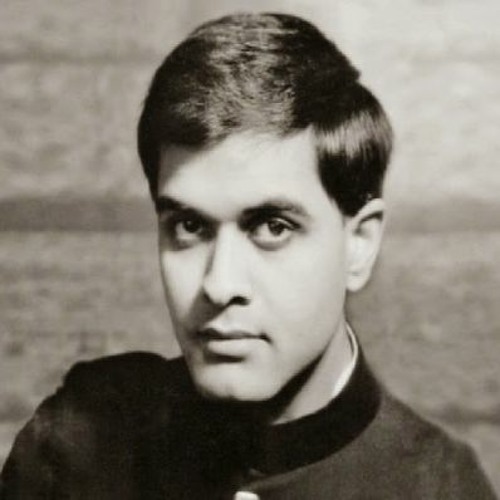
Above: Waris Hussein. Below: Sacha Dhawan and Jessica Raine as Waris Hussein and Verity Lambert in An Adventure in Space and Time.

Ten years ago, we got a historical docudrama paying homage to Doctor Who's difficult beginnings, when it was punted to a young minority producer and director expected to fail.
Last spring, the Radio Times published what I assume was one of its primary sources:
The 1963 Doctor Who diaries of Waris Hussein - part 2 - part 3
They're a fascinating read.
But while he's tactfully grateful to Doctor Who for helping launch his career, Waris Hussein has had a long, successful career since then, earning an Emmy, a BAFTA, and a slew of nominations, including one for the 1974 historical miniseries Shoulder to Shoulder (Youtube) on British suffragettes.
Here's a link to a good print interview with him. I also recommend listening to the beginning of this podcast interview, as his voice conveys the thoughtfulness he puts into everything:
(SNS Online is a podcast on all the usual platforms, if you want to look up pt 2.)
*Trivia note: Ian McKellan credits Waris Hussein with his first film role. The young director cut his teeth directing Cambridge peers McKellan, Derek Jacobi and Trevor Nunn (the token straight).

#waris hussein#british asian#lgbtq#(waris hussein is also gay although he had to be closeted for safety back in the day)#classic who
851 notes
·
View notes
Text
seeing 4 without his scarf feels wrong... like who is this man

#also his outfit slays i want it#i swear my closet is composed of only the doctors outfits#i just love his style ok...? :((#doctor who#dw#classic who#fourth doctor#4th doctor#planet of evil
284 notes
·
View notes
Text
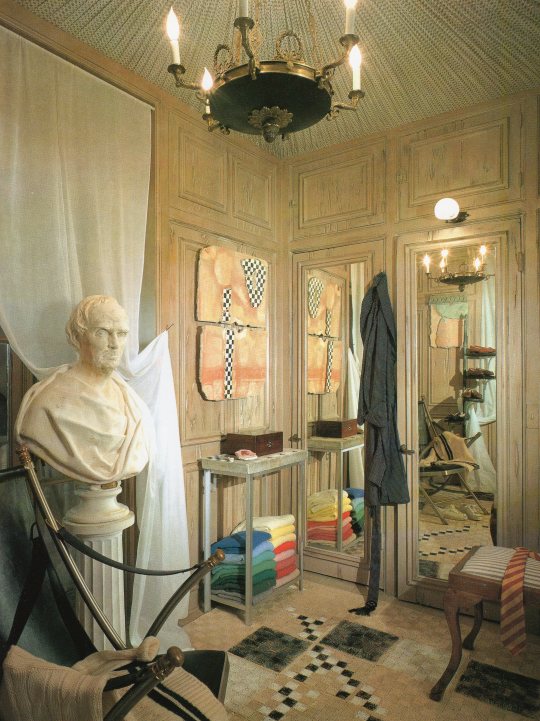
Interior Visions: Great American Designers and the Showcase House, 1988
#vintage#vintage interior#1980s#80s#interior design#home decor#closet#dressing room#chandelier#marble bust#antique#furniture#ruched fabric#ceiling#classical#style#home#architecture
242 notes
·
View notes
Text

☘️Look at this weird blue leprechaun I drew ☘️
#look at him#look at this small gold obsessed creature#how dare he have this exact outfit in his closet#anyways happy saint Patrick’s day#have this thing#sonic the hedgehog#classic sonic#sonic superstars#sonic mania#sonic origins plus#smol sonic#sonic#sonic tag#sth#saint patricks day#st patricks day#st pattys day#digital artist#digital art#my art shit#sth fanart#classic sonic style#sonic icon#leprechaun#sonic art#my art#drawing#art#art on tumblr#st paddys day
116 notes
·
View notes
Text
Cosplay the Classics: Elizabeth Montgomery in “Two”
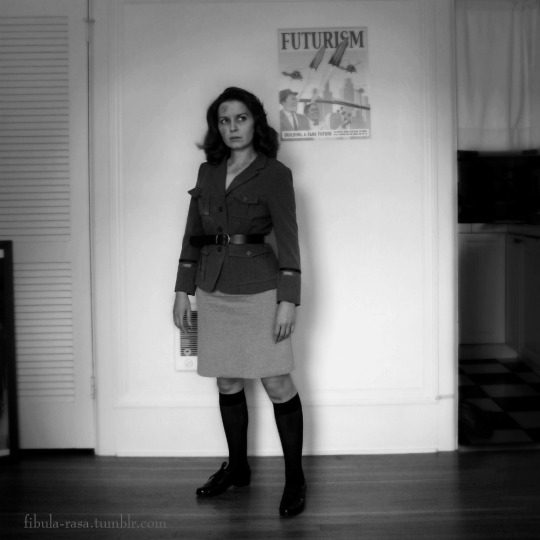
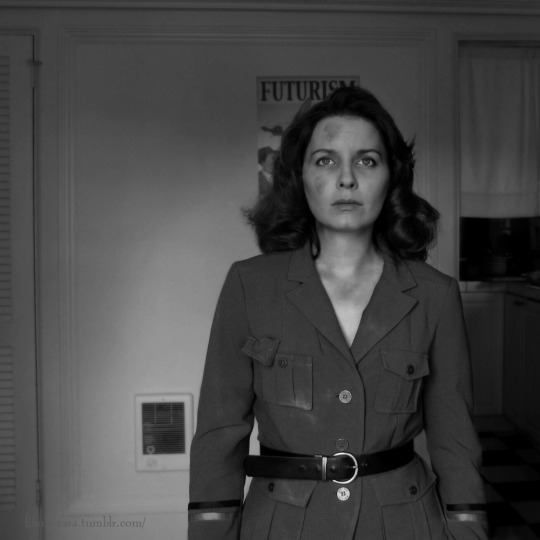

“Two” first aired on 15 September 1961 and is the first episode of the third season of The Twilight Zone. Sadly, “Two” is the only episode that features Elizabeth Montgomery.
Montgomery was nearly ten years into her professional career in 1961. She had already carved out a solid resume in television, appearing prolifically on anthology and episodic shows and occasionally stretched her legs on the New York stage. Samantha Stephens was still three years away when Montgomery took her voyage through The Twilight Zone.
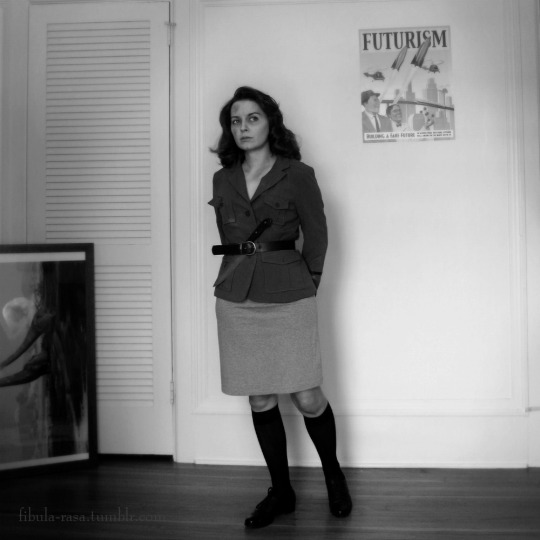

In its five seasons, The Twilight Zone was a crossroads of up-and-coming and well-established performers. “Two” paired the rising star Montgomery with Charles Bronson, who had a decade more acting experience in TV and film than Montgomery. Though Bronson was the more established star, “Two” is Montgomery’s showcase.

Read on below the jump!
“Two” relies on minimal dialogue throughout and notably Montgomery only has a single line spoken. The role relies almost entirely on Montgomery’s action/reaction, expression, and styling. The episode begins on Montgomery as The Woman wandering an abandoned city. The first nine minutes of the episode pass with no dialogue, with context given by visual elements and Serling’s opening narration. The entire episode takes place on a small section of city street (at the old Hal Roach studios, conveniently already in disrepair).
We learn through newspapers and magazines that this city is in The Man’s homeland, invaded by The Woman’s nation’s army. Signs of the city’s long five-year abandonment are everywhere, including full skeletons left where they fell. (The macabre element of skeletons is used sparingly across the Twilight Zone and usually in circumstances less grounded in reality than “Two,” such as “Long Live Walter Jameson” and “Queen of the Nile.”) As The Man mulls over his first encounter with The Woman a dove flies up behind him as a symbol of his genuine desire for peace. Through a variety of posters and advertisements, we learn that The Man’s homeland had a culture heavily invested in war.
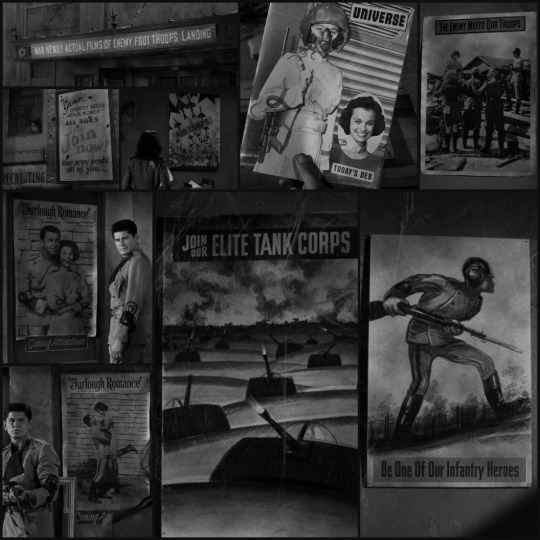
Collage of the war-related paraphernalia in “Two”
All of that is solid storytelling, but Montgomery’s acting adds an extra something. When The Woman first encounters The Man, Montgomery performs hair-trigger reactivity. Despite The Woman’s dire situation—a stranded foreigner in a decimated country with seemingly no chance to ever return home—her reluctance to trust The Man is significant. Pairing Montgomery’s wordless portrayal of these responses with the jingoistic quality of The Man’s homeland and the notable length of time that the city has been abandoned makes me feel that her feelings might not be a simple holdover of wartime hostility on her part but potentially extended trauma. Perhaps The Woman had previous awful experiences with other straggling remnants of The Man’s military, who may not have been as ready as The Man to give up wartime attitudes in spite of the war clearly being over.
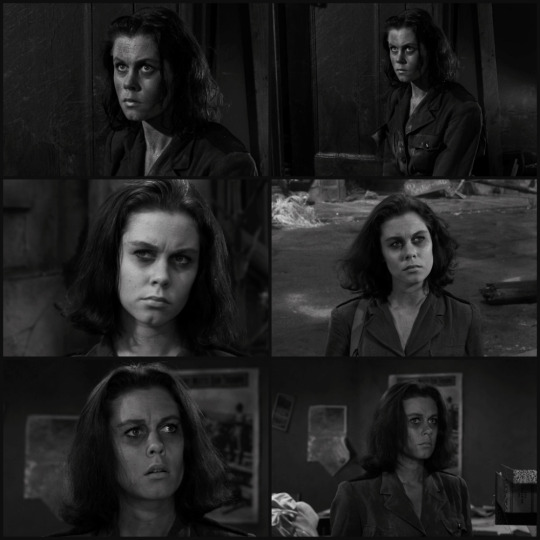
The Woman is understandably acting like a cornered animal. As the episode progresses, The Man tries to be as calculated as possible in communicating to The Woman that he doesn’t want a fight through his actions, turning his back to her, and not retaliating the third time she launches an attack on him. Montgomery, in turn, does a great job of drawing out the cornered animal characterization—alternating between curiosity, hope, mistrust, and open hostility. Montgomery’s characterization gives the role the added dimension that saves the episode from feeling too much like an overly simple fable.
Unfortunately, it’s in executing the fabular aspect of the story where “Two” falters. The opening narration by Serling specifies:
“It’s been five years since a human being walked these streets. This is the first day of the sixth year as man used to measure time.
“The time: perhaps a hundred years from now, or sooner, or perhaps it’s already happened two-million years ago. The place: The signposts are in English so that we may read them more easily, but the place is The Twilight Zone.”
It’s established here that the location is meant to be a stand-in for any city in any country, and that the use of English is merely a storytelling convenience. So, even though “Two” is intended as a Cold-War era anti-war statement, they are intentionally distancing the fiction from the contemporary real-world conflict. To create further distance from a contemporary place/time, they establish that the rifles are laser guns.
But, then, that one line that Montgomery speaks in “Two,” seventeen minutes in, is “Prekrasny” or “прекрасны,” a Russian word for beautiful or pretty. This pretty much grinds to a halt the concept that this is a cautionary fable and not a vision of a dark future where the Soviet Union and the United States moved to open warfare. While I’ll admit that the conventions used to establish “Two” as a fable are cheeky and a little on the corny side, the episode itself would have been stronger without the suggestion that The Woman is Russian.
I’m not sure who made the call to use a Russian word. I wonder if perhaps Serling wrote his introduction and he had a different read on the story than its writer, Montgomery Pittman. Maybe Pittman intended “Two” to be more of a dark premonition with a twist of optimism and Serling thought of it more as a fable and the two approaches hampered each other in the final product? This is pure speculation on my part of course, but it’s a black mark on what I think could have been an even better episode than it is.
Regardless, I think “Two” is a strong episode and a fine example of a Serling-esque story written by someone brought on to lighten the load of Serling, who worked himself to the bone on Twilight Zone. I also appreciate Pittman’s confidence to rely so heavily on visual storytelling techniques, taking into account that the high quality at which we watch the show now does not reflect the quality home viewers would have had in 1961. It reflects both Serling and the producers belief that viewers would be fully engaged in watching the show as it aired rather than just passively having it on in the family room while unwinding after dinner.
Elizabeth Montgomery’s performance heightens the whole affair considerably. That’s no shade on Charles Bronson, in fact I think the monologuing he’s given could have come off as unbearably hokey if delivered by a lesser actor.
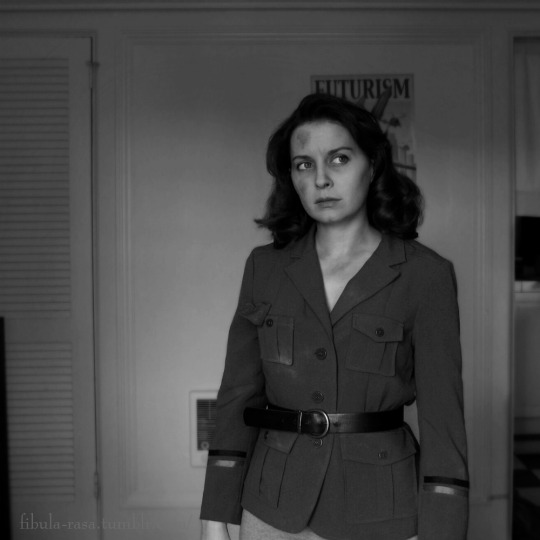

If you can believe it, this is my very first time cosplaying The Twilight Zone! (Though I did play Rod Serling in a set of sketches in high school. I was as weird as a teenager as I am an adult, okay?) If you didn’t already know, I run another blog called Twilight Zone in Close-ups, examining the powerful use of close-up shots on the show by testing out how much of each episode’s story can be communicated solely by its close-up shots.
☕ Buy me a coffee! ☕
#1960s#1961#elizabeth montgomery#the twilight zone#Twilight Zone#rod serling#classic television#television#closet cosplay#cosplay#television history#OTD#science fiction#speculative fiction#horror#1960s tv#tv
179 notes
·
View notes
Text
i'm really truly going insane. trapped in a haunted house with the personification of your insecurities. repressing and ignoring those insecurities made them so much more destructive that your loved ones can't help but notice. the most perilous life threatening situation is you, alone, looking in the mirror and seeing only the personified insecurity that wants you dead. the situation has become so disastrous that you have no choice but to open up and be vulnerable about it, but by this point the insecurity has grown so dangerously overpowering that it's too late.
#riz gukgak the absolutely insane guy you are#and by proxy. murph the insane guy that you are#i fear that i interpret baron very differently than others as more thematic than intended#to me they're so much a manifestation of riz's very obvious self esteem issues specifically regarding being closeted aroace#also regarding neurodivergence but that's more hc than canon#and in addition to being a crazy abstraction of the classic “goes to a different school” lie#actually you know what. im just gonna make a seperate separate post with my thoughts#carry on#fantasy high#fh#fhjy#riz gukgak#baron from the baronies#orating!
66 notes
·
View notes
Text
All Margot knows how to do is serve
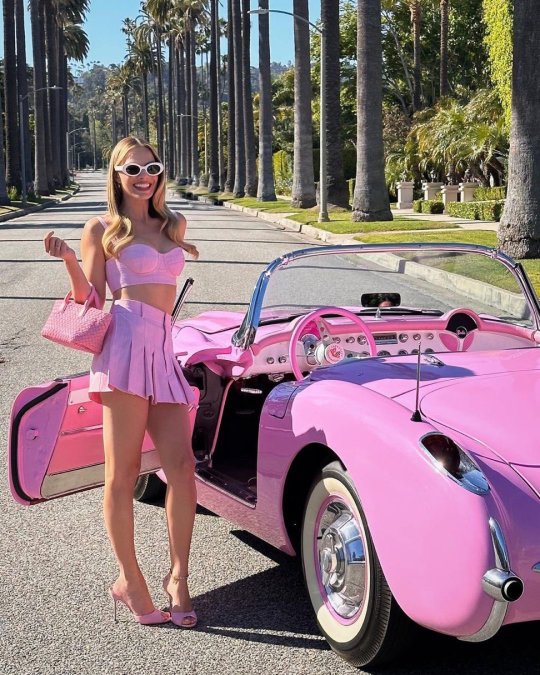

#80s barbie#barbie movies#ken and barbie#barbie barbie#barbie movie#barbie#barbie movie 2023#barbie my scene#barbie moodboard#margot robbie#queen margot#margotdaily#greta gerwig#barbie clothes#barbie classics#barbie closet
183 notes
·
View notes
Text



Black Barbie’s at the barbie premiere 🎀
#fashion#high fashion#black tumblr#luxurious#luxury#allbeautifulblackwomen#fashion model#black girl#fashion week#black woman power#black woman#melanin#barbie#barbiecastedit#barbie closet#barbie collector#barbie classics#barbie collectibles#barbie clothes#barbie core#barbiecore#barbie movie#barbie moodboard#pink moodboard#pink blog#hot pink#pink#pink aesthetic#pinkcore#allbeautifulblackgirls
163 notes
·
View notes
Text
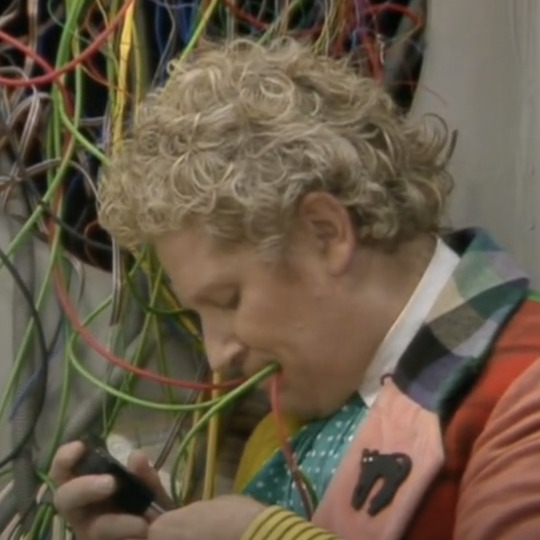

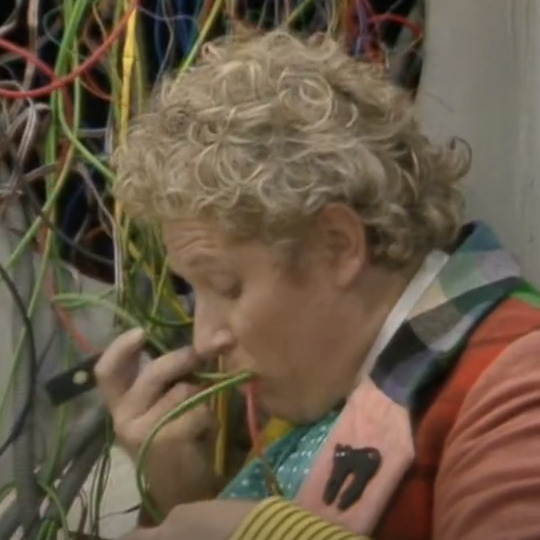
WHAT IS YOUR DEAL!!!!
#sorry this moment blindsided me and now I can't stop giggling#sixth doctor#it was very funny watching his moment while my cat was also trying to gnaw at my charging cable. something something life imitates art#peri get him away from the wires. please. every time he touches the tardis' internals she suffers some sort of catastrophic injury MANDSMAN#seeing him in a closet gnawing on wires while peri stands by the control panel like >:( is just <3 thank u classic who#peri you need to start kicking him in the knees i think. MNASDMAN#JUST GENTLY it'll be good for him#doctor who
35 notes
·
View notes
Text
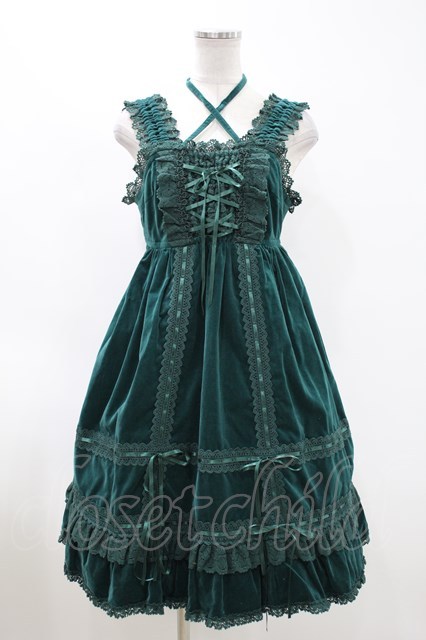


btssb velveteen babydoll jsk 💚 💚
#velveteen has a hold on me that i cannot explain#tartan and velvet tbh i cannot resist them#one of my dream dresses is defo a bttsb velvet baby doll in black or red#too expensive tho ;-;#btssb#velveteen#velvet#classic lolita#lolita#lolita fashion#egl#egl fashion#closet child#green#velveteen baby doll jsk#my posts#oldschool lolita#old school lolita
101 notes
·
View notes
Text
"She said her favorite color was purple, and now I haven’t seen purple the same since. I see lavender and think of her, I see her bedroom walls and dream of her, I wear purple t-shirts to feel her around me, I write love letters in purple crayon, because she makes my heart wild and carefree."
-Courtney Peppernell, "Pillow Thoughts III: Mending the Mind"
#once my mama told me that she likes pink colour and honestly after that i start wearing pink more and now half of my closet is this colour#and last month this girl said that she don't have any favorite colour and then when she's getting married she got to know his favorite#colour is purple and she wore everything in purple and now she have her own favorite color which is purple#dark academia#light academia#cottage core#dark acadamia aesthetic#dark fantasy#excerpts#fragments#poetry#books & libraries#romanticism#romantic literature#romatic academia#classic aesthetic#classic lit#classic literature#classic academia#lit#litblr#spilled ink#words#spilled love#spilled thoughts#spilled words#txt words#book quotes#quotes#peoms
693 notes
·
View notes
Text
OC Interview - Valerie Powell
I was tagged by @gloryride forever ago to interview my girl--Thank you, bb! I'm so late to doing this that I'm not gonna tag anyone else, but feel free to yoink it if you wanna do it!

[Answers are directly from Valerie's POV before the heist in 2077.]
.ೃ࿔*:・ NAME?
Valerie Irene Powell. [laughs] Yeah, my initials are VIP. My dad had a dorky sense of humor, and my mom let him get away with it. "Irene" is my great-grandmother's first name on her side of the family.

.ೃ࿔*:・ NICKNAME?
Pretty much just "V" these days, which was all Jackie's doing. A lot of the staff and some regulars at Nishimura's used to call me "Blue," but that was ages ago. Overly familiar acquaintances who don't know me well but think they do usually call me "Val."

.ೃ࿔*:・ GENDER?
Biologically female, no gender alterations or augmentations.
A/N - Valerie is a cis woman, but I don't see that specific language being in her vernacular.

.ೃ࿔*:・ STAR SIGN?
I was born in Night City on October 12 2041. Misty tells me that makes me a, uh--Hey, Misty, what am I again?
[Misty, calling from the other room: Libra Sun with a Taurus Moon and Scorpio Rising!]
Yeah, that. [laughs] Whatever the hell that even means.

.ೃ࿔*:・ HEIGHT?
Tall. 5'10" or 178 cm. And I admit I have a weakness for a sexy pair of heels, so I usually look a lot taller.

.ೃ࿔*:・ ORIENTATION?
People are out here fucking cyborgs with four eyes and chicks with gold dicks and electric nipples--What does this even mean? [laughs] I've never given it much thought. I like what I like, and I've liked a lot of different types of people with a lot of different things going on. [laughs again]
A/N: I say Valerie is bi, because that is the contemporary real-life word that best reflects her sexuality for me when I'm talking about her, but when I was really thinking about it from her POV and in the context of her world, I don't think she'd be too hung up on a label. She'd also probably see her wide spectrum of attraction as closer to the default, not the exception.

.ೃ࿔*:・ NATIONALITY/ETHNICITY?
I'm a typical American mutt. My dad's side of the family can mostly be traced back to Western Europe--my grandmother told me "Powell" is an Anglicized form of an old Welsh surname--and my mom's side is from the Eastern Mediterranean. Dad's side has been in NUSA for a long time (like two centuries before it was even called NUSA), but Mom's family has only been here for a few generations.

.ೃ࿔*:・ FAVE FRUIT?
I just love fresh fruit. It's such a rare treat in Night City--I'll take fresh strawberries or melons over any other kind of sweet treat.

.ೃ࿔*:・ FAVE SEASON?
Spring! When everything starts turning green and flowers are blooming. There aren't a ton of places in Night City where you can really experience that, but I know a few hidden gems.

.ೃ࿔*:・ FAVE FLOWER?
Hydrangeas, probably. Especially the blue and purple ones. Oh, and wisteria! A tree covered in blooming wisteria is one of the most beautiful sights I've ever seen.

.ೃ࿔*:・ FAVE SCENT?
Freshly brewed coffee; new car smell; woodsy, smokey colognes and perfumes; real leather; whatever incense Misty uses in her shop; clothes right out of the dryer; lavender; a ton more that I know I'm forgetting!

.ೃ࿔*:・ COFFEE, TEA, OR HOT CHOCOLATE?
Strong coffee, black, maybe a little sugar if I'm feeling indulgent. Tea is nice, but it's not my caffeine fix. I like a cup of lavender or chamomile tea at night. Hot chocolate is too heavy and rich for my taste. A sip is nice, but I could never finish a cup.

.ೃ࿔*:・ AVERAGE HOURS OF SLEEP?
I try not to get any fewer than 6 hours, but that's easier said than done some nights. Okay, most nights.

.ೃ࿔*:・ DOG OR CAT PERSON?
You know, I've only ever seen one dog in person. A childhood friend's family had one--I don't know the breed, but it was a yippy little shit and it bit me! Never really wanted to see another dog, if I'm honest.
I like cats, though. There's a stray that hangs by Misty's place--He's the sweetest little guy. I picked up a bag of kibble we keep there to feed him when he comes around.

.ೃ࿔*:・ DREAM TRIP?
I've actually traveled a lot--My parents had to go to Biotechnica's HQ in Rome a few times when I was a kid, and they usually turned those trips into an excuse to have an extended European vacation. And I went all over the globe working for Arasaka for 7 years. I'd love to go back to Japan for non-work reasons.

.ೃ࿔*:・ FAVORITE FICTIONAL CHARACTER?
You're gonna laugh, it's so predictable. In my defense, I can't remember the last time I watched or read anything new--Actually, that's not true. Jackie made me watch one of those Bushido movies last week, and I just don't get it. Anyway. It's Elizabeth Bennet. Don't look at me--What's the next question?

.ೃ࿔*:・ NUMBER OF BLANKETS YOU SLEEP WITH?
Just a sheet and comforter.

.ೃ࿔*:・ RANDOM FACT?
Oh, no, don't put me on the spot like this! [laughs] Um, okay, I shot my first firearm when I was about 7. Under intense adult supervision--My dad was really serious about self-defense and the right to bear arms, which always surprised people because he came across as such a meek science nerd. I didn't like it--It was so loud, even with earmuffs. Funny how things change.
Is that kind of a heavy note to leave on? [laughs again] Okay, how about this one: I can't roll my tongue.
#fem v#female v#fem v friday#oc: valerie v powell#g: cyberpunk 2077#long post#so the fave character one really confounded me bc who the fuck are fictional characters in this world lmao#and then i was like well we could go classic lit since that still exists#and valerie was a bit of a book nerd when she was younger#and i was like omg valerie is 100% a closet romantic we gotta go austen#and the gender and orientation ones stumped me a bit too bc i just really don't think these would be seen the same way as they are irl#i think valerie would find both questions kind of odd#this was a lot of fun to do though#and the nickname thing was a bit of fun projection from my own irritation at acquaintances calling me a shortened version of my name#that i dont like lmao
28 notes
·
View notes
Text
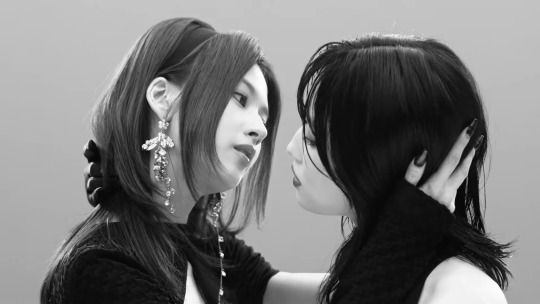


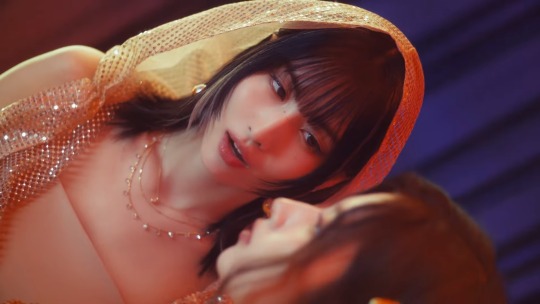
what if i EXPLODE
#the most basic and classic kpop queerbait pose but i still love it youre right#the lyrics during these scenes too this is a song for women and sapphics#they did this for the gay closeted church girls#i literally had a hand over my mouth gasping shocked shaken the entire mv GAOWD im giving the japan division a big kiss rn#momos wolfcut too IM GONNA GJRKDUWP38RBJ#the bridge was so good mina always serves she has given and she has never disappointed!#i LOVE the way sana sang the mmm humming part in the beginning it reminds me of her lines in wallflower and YEAH SHES STILL THE BEST AT IT!#and momos rapping OHHHHHH she has truly never not killed a rap her deep raspy voice is so perfect omg#them turning into paintings in the end YEAH POETIC CINEMA#so glad they made this a littke gay bc all art is inherently gay no im not elaborating#yes obv i saw minas back they had no business putting it there not even 30 secs into the song what if i actually combusted#having this AND oec air force one in one week if god hates the gays why do we always win 👩❤️💋👩
114 notes
·
View notes
Text
Cosplay the Classics: Natacha Rambova
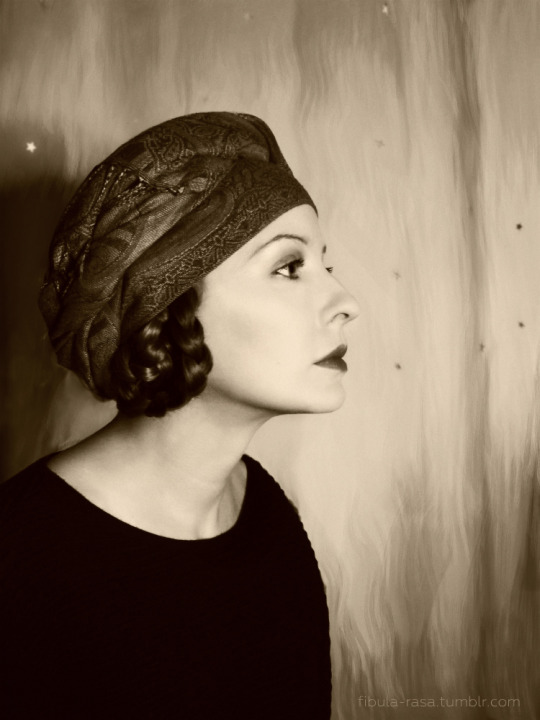
My closet cosplay of Natacha Rambova’s signature look from the 1920s
It’s unbearably common for people who have written about Natacha Rambova to emphasize that her “real” name was “Winifred Hudnut.” In reality, Rambova had about a half dozen names she went by (or could have gone by). Natacha Rambova was the name she took when she began her working life as a teenager with Theodore Kosloff’s ballet company—hence the Russophone name. And, as Rambova was a person who first and foremost lived to work, sticking with her professional name seems true to her character, Slav or not. You see, the primary reason Rambova was (and is) subjected to this passive-aggressiveness is part of a lingering effort to delegitimize her and her work. Sometimes that takes the form of calling her Winifred Hudnut and sometimes “Mrs. Valentino.” While there are valid reasons to criticize Rambova and her work, the aspersions typically lobbed at her fully miss their mark because they’re motivated by the desire to belittle a woman who knew the value of her work and her art and had the necessary privilege to fight for it.
"Natacha Rambova seems to belong most to me, the individual I think I am, but of course, I wasn’t born that way."
—“Wedded and Parted” by Ruth Waterbury, Photoplay, December 1922

Collage of portraits of Rambova from the 1920s
READ ON below the JUMP!
To begin at the beginning, Rambova was born as Winifred “Wink” Shaughnessy in Utah in 1897. Her father, who was significantly older than her mother, was found lacking as a parent and a spouse, and the Shaughnessy’s divorced when Rambova was young. Her youth was spent bouncing between her mother’s home in San Francisco, boarding school in England, and her aunt’s villa in France. Early on Rambova discovered two of the great passions of her life, ballet and mythology. The latter became an enduring fascination that guided Rambova’s varied pursuits throughout her life.
At first, her family encouraged Rambova’s interest in ballet. However, around 1914, when Rambova was 17, the shady nature of Rambova’s relationship with Kosloff was discovered by her mother, who tried to have Kosloff deported. At the time, Kosloff was supporting a wife and child back in England while keeping house with Rambova and another of his dancers, Vera Fredova (who was also legally named Winifred and also a teenager btw). Mom called off the lawsuit, and for years Kosloff, Rambova, and Fredova ran the ballet company together.
The company relocated to Los Angeles where Kosloff entered into a contract with Cecil B. DeMille. The company would provide art and costume designs for DeMille’s films and Kosloff himself would appear in the films. While Kosloff’s name is found in the credits for most of these films, it’s now widely accepted that Rambova was doing most, if not all, of the research and design work.

Theodore Kosloff in his costume from The Woman God Forgot (1917) on the left with Rambova (who does not appear in the film)
In this creatively productive period, Rambova shifted her focus away from dance toward historical research and costume and set design as her primary endeavor. For DeMille, Rambova contributed designs for The Woman God Forgot (1917), Why Change Your Wife? (1920), Something to Think About (1920), and also designed the Cinderella fantasy sequence of Forbidden Fruit (1921).
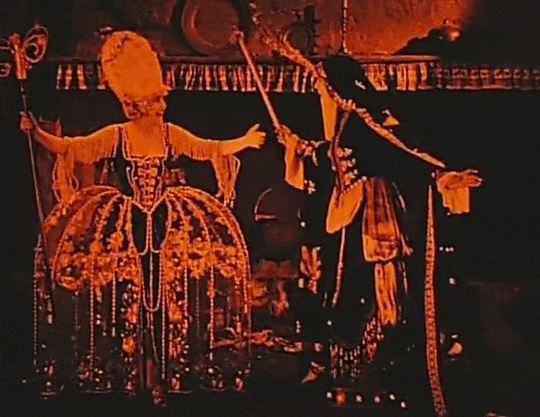
from the Cinderella sequence of Forbidden Fruit [more gifs here]
The work caught the eye of Nazimova, who was still working at Metro at the time. Once Nazimova realized that Rambova was the one doing the work, she engaged her directly to work on her now lost film Billions (1920). Rambova would receive on-screen credit for her art direction on Nazimova’s final film for Metro, the deco-bonanza Camille (1921).
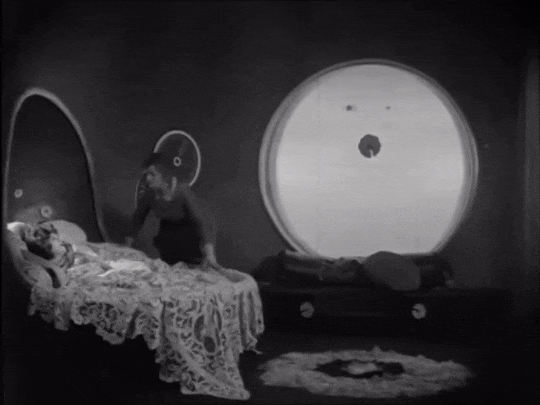
from Camille [more gifs here]
Camille features designs verging on the bizarre, using circles and half-circles as a consistent symbolic motif throughout the film. One of my personal favorite touches however, is the sequence taking place at Armand’s country cottage. Where the Paris sets are oversized and characterized by rounded edges, the cottage is excessively square and feels almost claustrophobic. At this point in the story, Marguerite is conflicted, she feels happier and freer than ever before in her love with Armand, but is also haunted by the notion that she’s dooming him given her past and her illness. The interior of the cottage feels more artificial because of its realism, almost like a doll house, in comparison to the more heavily designed Paris settings. This highlights the feeling in Marguerite that she’s just playing pretend at a happy, heteronormative fantasy.

country house setting from Camille
Influenced by the highly stylized visuals of ballet but also preoccupied with historical research and symbology, Rambova’s designs stand out from anything else produced in this period, especially in the US. The more I study her designs and think about how young she was when she created them, the more impressed I am by them. Faced with challenging assignments, Rambova balanced accuracy and perceived authenticity with her penchant for larger-than-life symbolism. On top of all that, they photograph beautifully! Being able to create interesting and appropriate costume and set designs with a demonstrated understanding of how they would register on film is a sophisticated skill set which Rambova deserves significant credit for.
When Nazimova went independent following Camille, she brought Rambova with her. The first two projects Rambova would work on for Nazimova’s company were A Doll’s House (now a lost film, which I profiled on my Lost, but Not Forgotten series) and Salomé (1922). The latter has become regarded as Nazimova’s magnum opus on film and often referred to as America’s first art film. For Salomé, Rambova translated illustrations made by Aubrey Beardsley into three-dimensional sets and costumes and character designs for film. If you’ve seen Beardsley’s illustrations and you’ve seen the film, you know this was no simple task and that Rambova did a phenomenal job of re-working the illustrations into wearable costumes and weaving elements of Beardsley’s illustrations into the set design.
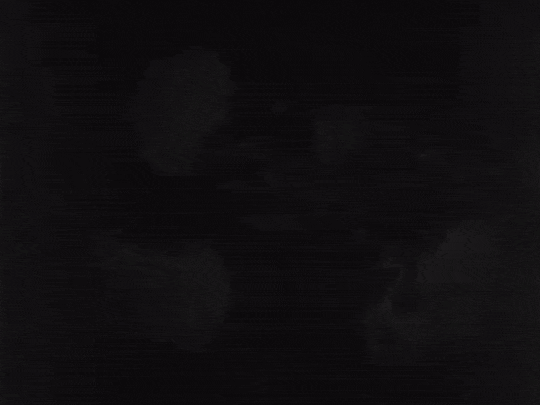
from Salomé [more gifs here]
Taking a second to emphasize Rambova’s range, her work on Why Change Your Wife?, Something to Think About, and A Doll’s House (which we can only judge by surviving stills) are contemporary settings with more realistic, grounded set and costume designs. Rambova executes the designs for these films with just as much skill, although as she admitted herself, with less gusto because they didn’t scratch the historical-research/symbology itch.

production still from A Doll’s House
It was in this same period of creative growth that Rambova split from Kosloff (and he shot her in the leg on the way out) and she started seeing her future husband, Rudolph Valentino. Valentino, however, was still legally married to another woman. This would lead to significant trouble for the couple in the first few years of their relationship.
Perhaps too much time has been spent picking apart the nature of the Valentino-Rambova pairing—most of it spent trying to characterize her as a Svengali type and Valentino as too immature or unintelligent to have any opinions of his own. Now, having read most of what Rambova has written about Valentino, both before and after their divorce, she often takes a paternalistic attitude toward Valentino, but one tempered by real affection. And, given how close Valentino became with her family (and remained close after the divorce, even leaving a significant part of his estate to her aunt), to doubt the legitimacy of their partnership feels willfully disingenuous. Valentino shared Rambova’s desires to elevate the artistic qualities of film, oftentimes beyond their means. Together they crafted the romantic idol of Valentino. Together they challenged the studios for underpaying him.
“Some producers find an unusual personality. They use up thousands of dollars to exploit it. They put that personality into a picture and the picture goes over and makes a million. Then, instead of letting the actor who does fine work go on doing it, they give him cheap material, cheap sets, cheap casts, cheap everything. The idea then is to make just as much money from that personality as possible with the least outlay.
“Isn’t it short-sighted? Isn’t it unwise? Yet they do it again and again. But they can’t keep it up forever. The fans are beginning to wake up. They refuse to take second rate products even when a big personality is exploited. They are doing the one thing that will affect the producer—when poor pictures are offered them, they are staying home.”
—from “Wedded and Parted” by Ruth Waterbury, Photoplay, December 1922
Something I mentioned in the last installment of “Lost, but Not Forgotten” was that in this period, a number of film artists in Hollywood were recognizing the true value of their work and going independent of the emergent studio system. Studio heads saw no problem in curtailing the creative freedom of their artists to further pad their overflowing wallets. For the founders of United Artists, the system was usually able to be bent in their favor, with their films getting wide releases with decent promotion budgets. For a number of other independent artists, the road was rockier as distributors and exhibitors were reluctant to offend the increasingly powerful studios. Nazimova was one of those who eventually ran out of funds to produce their own work. Valentino’s star rose precipitously after The Sheik (1921) and Blood and Sand (1922) was a massive box-office hit, but Valentino’s salary did not match that bankability. This financial dispute, complicated by negative press around his relationship with Rambova, left Valentino out of work in film for a year. In turn, Valentino and Rambova went on a dancing tour of the country, which raised her profile as a public figure while bolstering his star image despite not appearing in any new films.

Valentino and Rambova in a promotional photo for their dance tour
Unfortunately, crossing the studio system as they did resulted in a coordinated campaign to take them down a notch. Reading film magazines from the period will give you whiplash. Many of these magazines had established relationships with studios and ran news items in keeping with whatever narratives the studios wished to push. However, the stars and their managers (if they had them) had their own relationships with the magazines. So, occasionally, you’ll find items deriding Rambova as some kind of artsy-fartsy manipulative phony and then a profile piece of her or Valentino that’s sympathetic to their business woes. This is the period where the narrative emerges of Rambova as a calculating climber, using Valentino to build her own career. This talking point is often repeated today, despite the fact that Rambova had already been working on big productions for DeMille and Nazimova for years before meeting Valentino. While Rambova was certainly a key figure in developing Valentino’s star image, the plain facts make it apparent that they were working as a team—hardly abnormal. Unfortunately, neither member of said team had much in the way of business sense.
As I mentioned earlier, Rambova fashioned her life around her work. Something I didn’t mention earlier is that she was an heiress. At this point in her life, Rambova was determined to live off her own labour and not touch her inheritance. When they were battling the studios, the couple continued to not touch Rambova’s inheritance. And, both desperate to return to filmmaking, they were subject to the studio’s will. While their split is often framed as Rambova abandoning Valentino when she was denied the ability to control his career, a slightly different scenario emerges upon closer inspection. Both Valentino and Rambova were highly dedicated to their work and their work was intertwined with their relationship, a similar dynamic to Rambova’s relationship with Kosloff and later with her second husband Álvaro de Urzáiz, with whom she restored villas. With Urzáiz, their relationship degraded when they no longer had a shared project to work on. (In this case due to the Spanish Civil War.) It’s neither sensational nor romantic, but following Valentino’s reconciliation with Hollywood, after a few films, the pair was intentionally separated creatively. (This was at least partly due to the machinations of their new business manager, George Ullman, who we now know was manipulating Valentino’s finances after litigation regarding the disposition of Valentino’s estate.)
“What I desire personally is simply to be known for the work which I have always done, and that has brought me a reputation entirely independent of my marriage.”
—“Natacha Rambova Emerges” by Edwin Schallert, Picture Play Magazine, August 1925
Rambova worked on one film independently from Valentino before their divorce, What Price Beauty? (1925), starring mutual friend (for the moment) Nita Naldi. The film is now lost and its production and release seems awfully sus, so I hope to cover that for “Lost, but Not Forgotten” soon. Regardless of the film’s success or failure, the whole endeavor soured Rambova on Hollywood.

Nita Naldi in a promotional photo from��What Price Beauty?
In her book about her life with Valentino, Rambova opined:
“Hollywood—all the joys of the petty community life of ‘Main Street’ with an additional coating of gold dust thrown in for good measure!… it is merely an imitation gilded hell of a make-believe realm. Nothing but sham—sham—and more sham.
“Hollywood—one continuous struggle of nobodies to become somebodies, all pretending to be what they are not.”
Through their divorce and Valentino’s untimely death the year following, Rambova never stopped working. Rambova operated boutiques selling her original designs in New York and then in France. Around this same time Rambova also got more deeply involved in spiritualism. In an odd move, she published Rudy with the final third of the book “dictated” by Valentino’s spirit. I won’t say that I don’t find that pretty distasteful, but having read the book, it reveals two key things: Rambova’s genuine affection for Valentino, patronizing as it may be, and a sincere belief in the spiritualism movement that she and her mother had been drawn into. There have been critics who have framed the book as some sort of cash-in or vengeful act against Valentino for excluding her from his will, but the facts do not support that. Rambova, to reiterate, was an heiress who did not need to work for a living. She also states directly that it is Rambova’s spiritual leader who encouraged her to publish the book as a way to promote spiritualism. That’s not necessarily any better than the false narrative, but the truth has value (and is more interesting in this case!)
In the 1930s, Rambova relocated to Spain where she finally began using that inheritance to develop rental properties on Mallorca with her aristocrat husband. If you know anything about 20th century European history, you may know what happened next. Urzáiz joined the fascists in the Spanish Civil War, and despite her abiding fear of Communists, Rambova stuck around in Spain for as long as she could before fleeing to France. Of course, it wasn’t long before the Nazi Germany invaded France, so Rambova relocated back to the United States.
During her time abroad, Rambova’s preoccupation with symbology was reignited by a trip to Egypt. This sparked the next big passion of her life, which she would pursue for over two decades: Egyptology.

Rambova in Egypt
Rambova became a writer, researcher, and lecturer on symbolism and cosmology in Ancient Egypt (as well as spiritualism). Much of Rambova’s work was done in collaboration with Alexandre Piankoff and the French Institute for Oriental Archaeology in Cairo (IFAO). With various grants, Rambova travelled to Egypt to document important sites, via photography and illustration. Rambova also used much of her inheritance to source objects from Egypt, which she donated to museums and universities in the US. (There’s a huge discussion about that to be had, which, as an archivist myself, I am drawn to explore. But, it falls outside the purview of this blog, so it’ll have to stay a discussion for another time and place.) These collections are still accessible to researchers and the public today. Rambova continued this work until her death in the 1960s.
Without doubt there are meaningful reasons to criticise Rambova and her work. Some of her design work is appropriative at best, overtly racist at worst. She had ignorant and arrogant attitudes toward class politics bred from her uber-privileged upbringing, which occasionally bled into her work and interfered with her ability to collaborate with other artists. She definitely lacked the social skills and business sense that were very necessary for artists working in a mass-media format like film. It’s typical, but disappointing still, that so much effort has been put into demonizing Rambova for reasons that were either completely fabricated, or rooted solely in the fact that she was a woman who knew her value, but by society’s standards, didn’t know her place. All that said, maybe we are due to spend a bit more time as film enthusiasts genuinely engaging with the art Rambova created and recognizing how much of a force she was in standing up for artistry in the American film industry.
☕Appreciate my work? Buy me a coffee! ☕
Postscript: This piece was a monster, so excuse me for not diving into rumours about Rambova’s potential queerness, as it eventually fell out of the scope of the essay. But, for those in the know: my personal take is that she likely was queer, though probably not romantically entwined with Nazimova, but maybe with Fredova. I also think her marriage with Valentino was not lavender. And, even if Rambova wasn’t queer, I appreciate what a keen collaborator she was with queer colleagues and what a good friend she apparently was to queer people in her social circles and her family, despite how often her detractors would try to use accusations of lesbianism as a weapon against her. IMO if someone were of weaker character, those types of aspersions would have driven a wedge between the object and their friends and colleagues.
Bibliography/Further Reading:
Madam Valentino: The Many Lives of Natacha Rambova by Michael Morris
Rudy: An Intimate Portrait of Rudolph Valentino by His Wife Natacha Rambova
Valentino As I Knew Him by George Ullman
Picture Play Magazine, August 1925
Photoplay Magazine, December 1922
Mythological Papyri – Texts by Alexandre Piankoff & Natacha Rambova
#1920S#natacha rambova#film history#cosplay#cosplay the classics#closet cosplay#film#american film#cinema#silent cinema#classic film#classic movies#old hollywood#self portrait#silent movies#silent era#long reads#silent film#costume design#art direction#set design#nazimova#alla nazimova#classic cinema#classic hollywood#hollywood
17 notes
·
View notes
Text

Outfit inspo + a haiku???
Thou soul drapes like silk
Upon the breast, smooth as rain
That sings of rapture
- t.h. ballard
#classic literature#dead poets society#poetry#writers and poets#classic poetry#dark academia#light academia#anthropology#philosophy#prose#romantic academia#lovers#clothing#academia outfit#dark academia clothing#aestehtic#closet#vintage#vintage clothing
334 notes
·
View notes
Text
"rare intersex variation"? actually, i prefer "limited edition intersex"
#i'm a shiny pokémon. i'm a gold holo numbered digimon card#i'm that one character in every fantasy book that's the last of their species#i'm that one weird bug you see once and can never find the name of and never see again#intersex#original post#classic leg pulling#rainbow skeletons in my closet
51 notes
·
View notes